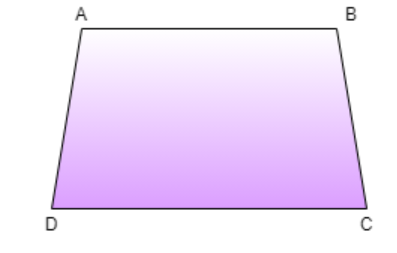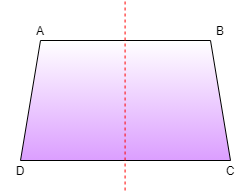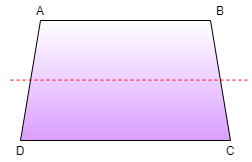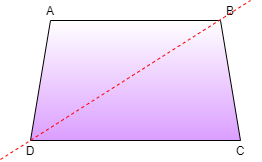
How many lines of symmetry does trapezoid have?
A. 1
B. 2
C. 3
D. 4
Answer
578.7k+ views
Hint: Before attempting this question one should have prior knowledge about the concept of line of symmetry according to which the line divides the shape into identical halves also remember to draw every possible line of symmetry on the given shape, using this information can help you to approach towards the solution of the question.
Complete step by step answer:
Before approaching the solution let’s discuss the line of symmetry which can be explained as an imaginary line or axis which divides the shape or object into equal halves after passing through the center of the shape or object.
We know that the trapezoids have 4 sides with 2 opposite sides parallel to each other, so let’s construct a trapezoid ABCD to find the number of lines of symmetry possible.

Now constructing the line of symmetry in different ways in the above diagram to identify the numbers of possible lines of symmetry can be formed.
First let’s construct the line of symmetry vertically in the above diagram

So we can say by the above diagram that when a line of symmetry is drawn is drawn vertically it divides the trapezoid into 2 identical halves.
Now constructing the line of symmetry horizontally we get

It can be easily noticed that when the line of symmetry is drawn horizontally the trapezoid doesn’t divide into 2 equal halves.
Now constructing the line of symmetry from D to B we get

Thus the trapezoid is not equally divided into 2 equal halves when the line of symmetry is drawn from D to B.
Now constructing the line of symmetry from A to C we get

For this case also the line of symmetry when drawn from A to C the trapezoid is not divided into 2 equal halves.
From all the cases mentioned above we can say that for trapezoids only 1 line of symmetry is possible.
So, the correct answer is “Option A”.
Note: In the above solution we found that the trapezoid has only one line of symmetry but do you know what trapezoid is? trapezoid is one of the quadrilateral which consist of 4 sides where 2 sides are opposite and parallel to each other there are also different type of trapezoid like in the above solution we only considered the isosceles trapezoid but it is not necessary that for every type of trapezoid the number of line of symmetry is one some trapezoid doesn’t have a single line of symmetry for example right trapezoid and scalene trapezoid.
Complete step by step answer:
Before approaching the solution let’s discuss the line of symmetry which can be explained as an imaginary line or axis which divides the shape or object into equal halves after passing through the center of the shape or object.
We know that the trapezoids have 4 sides with 2 opposite sides parallel to each other, so let’s construct a trapezoid ABCD to find the number of lines of symmetry possible.

Now constructing the line of symmetry in different ways in the above diagram to identify the numbers of possible lines of symmetry can be formed.
First let’s construct the line of symmetry vertically in the above diagram

So we can say by the above diagram that when a line of symmetry is drawn is drawn vertically it divides the trapezoid into 2 identical halves.
Now constructing the line of symmetry horizontally we get

It can be easily noticed that when the line of symmetry is drawn horizontally the trapezoid doesn’t divide into 2 equal halves.
Now constructing the line of symmetry from D to B we get

Thus the trapezoid is not equally divided into 2 equal halves when the line of symmetry is drawn from D to B.
Now constructing the line of symmetry from A to C we get

For this case also the line of symmetry when drawn from A to C the trapezoid is not divided into 2 equal halves.
From all the cases mentioned above we can say that for trapezoids only 1 line of symmetry is possible.
So, the correct answer is “Option A”.
Note: In the above solution we found that the trapezoid has only one line of symmetry but do you know what trapezoid is? trapezoid is one of the quadrilateral which consist of 4 sides where 2 sides are opposite and parallel to each other there are also different type of trapezoid like in the above solution we only considered the isosceles trapezoid but it is not necessary that for every type of trapezoid the number of line of symmetry is one some trapezoid doesn’t have a single line of symmetry for example right trapezoid and scalene trapezoid.
Recently Updated Pages
Master Class 12 Business Studies: Engaging Questions & Answers for Success

Master Class 12 Economics: Engaging Questions & Answers for Success

Master Class 12 English: Engaging Questions & Answers for Success

Master Class 12 Maths: Engaging Questions & Answers for Success

Master Class 12 Social Science: Engaging Questions & Answers for Success

Master Class 12 Chemistry: Engaging Questions & Answers for Success

Trending doubts
Which places in India experience sunrise first and class 9 social science CBSE

Fill the blanks with the suitable prepositions 1 The class 9 english CBSE

Write the 6 fundamental rights of India and explain in detail

Difference Between Plant Cell and Animal Cell

What is pollution? How many types of pollution? Define it

What is the full form of pH?




